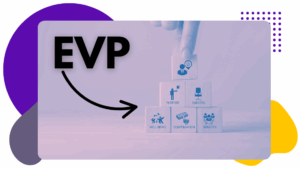In today’s fiercely competitive talent landscape, attracting and retaining top-tier professionals goes far beyond offering a good salary and benefits. Candidates are seeking more than just a job; they’re looking for a purpose, a supportive culture, and a place where they can truly thrive. This is where your Employer Value Proposition (EVP) comes in.
 For talent acquisition professionals, a well-defined and authentic EVP is your most powerful tool. It’s the unique set of benefits, opportunities, and experiences an employee receives in return for their skills and contributions to your company. It’s the “why” behind working for you, and it’s what differentiates you from every other employer out there.
For talent acquisition professionals, a well-defined and authentic EVP is your most powerful tool. It’s the unique set of benefits, opportunities, and experiences an employee receives in return for their skills and contributions to your company. It’s the “why” behind working for you, and it’s what differentiates you from every other employer out there.
A truly effective EVP is multi-faceted and often not publicly summarized in a single, simple statement. It’s about the entire employee experience.
However, based on widely recognized employer branding, employee satisfaction, and common themes they emphasize, here are five Fortune 500 companies often cited for strong or influential EVPs, along with the core elements they tend to highlight:
- Google (Alphabet):
- Core EVP Elements: Innovation, impact, intellectual challenge, autonomy, comprehensive benefits (including unique perks like free food, wellness programs), and a culture that fosters creativity and connection (“Do cool things that matter“). They attract top technical talent by emphasizing cutting-edge projects and the opportunity to work with brilliant minds on a global scale.
- Microsoft:
- Core EVP Elements: Growth mindset, global impact, diverse and inclusive culture, work-life flexibility, and world-class benefits and development opportunities. Under Satya Nadella’s leadership, Microsoft has significantly shifted its culture to one that emphasizes empathy, learning, and making a difference in the world through technology.
- Apple:
- Core EVP Elements: Purpose-driven work, passion for innovation, design excellence, a collaborative and intense work environment, and the opportunity to shape the future of technology and culture. Their EVP appeals to individuals who are driven by creating groundbreaking products and who align with Apple’s pursuit of perfection and iconic brand.
- Johnson & Johnson:
- Core EVP Elements: Meaningful work in healthcare, global impact, strong values (the Credo), career development, and a commitment to diversity and inclusion. Their EVP often focuses on the direct impact employees have on human health and well-being, fostering a sense of purpose and contribution to a greater good.
- Unilever:
- Core EVP Elements: Purpose-driven brands, sustainable business practices, leadership development, global career opportunities, and a diverse and inclusive environment. Unilever emphasizes building future leaders and making a positive impact on the world through its widespread consumer products and commitment to sustainability.
These companies consistently rank high in “best places to work” lists and are known for their ability to attract and retain top talent, largely due to their well-articulated and genuinely lived EVPs.
But how do you uncover this unique “soul” of your company and articulate it in a compelling way like the brands above? It’s a journey of research, introspection, and refinement. Let’s dive into the essential steps.
Step 1: Understand Your Current State – The Internal Pulse Check
Before you can define your ideal EVP, you need a crystal-clear understanding of what it’s actually like to work at your company right now. This isn’t about what you think your culture is, but what your employees experience.
- Employee Surveys: Conduct anonymous surveys to gather feedback on various aspects of the employee experience. Ask about compensation and benefits, work-life balance, career development opportunities, leadership, company culture, recognition, and overall satisfaction. Tools like engagement surveys are invaluable here.
- Focus Groups & Interviews: Go deeper with smaller, facilitated discussions. These provide qualitative insights and allow employees to express nuances and share personal stories. Consider having an impartial third party facilitate these to encourage honesty. Ask questions that uncover:
- What motivates them to stay?
- What makes them proud to work here?
- What improvements would they like to see?
- What differentiates us from past employers?
- Exit Interviews: Analyze data from past exit interviews to identify recurring themes for why employees leave. This provides crucial insights into potential gaps between your perceived EVP and the reality.
- Leadership Interviews: Talk to leaders across different departments to understand their vision for the company culture and what they believe the company offers its employees.
- Review Existing Materials: Scrutinize your career page, job descriptions, onboarding materials, and internal communications. Do they accurately reflect the current employee experience?
Key takeaway: Your EVP should be 80% grounded in reality and 20% aspirational. Don’t promise what you can’t deliver. Authenticity is paramount.
Step 2: Look Outward – The External Landscape & Competitor Analysis
Once you have a solid internal picture, it’s time to understand your position in the broader talent market.
- Competitor Analysis: Research the EVPs of your direct and indirect competitors.
- What are they highlighting on their careers pages, social media, and job postings?
- What benefits and perks do they offer?
- What’s their public perception like (Glassdoor, LinkedIn reviews)?
- Where are your strengths and weaknesses in comparison?
- Target Candidate Personas: Develop detailed personas for the talent you want to attract. What are their priorities, motivations, and pain points? What do they value in an employer? This will help you tailor your EVP to resonate with specific talent segments.
- Market Trends: Stay abreast of broader talent market trends. Are flexible work arrangements becoming a non-negotiable? Is purpose-driven work gaining more importance? Understanding these shifts will ensure your EVP remains relevant.
Step 3: Define Your EVP Pillars – The Core Components
Based on your research, identify the key themes and benefits that truly define your unique employee experience. These will become your EVP pillars. Common pillars often include:
- Compensation & Benefits: Beyond salary, consider bonuses, equity, health benefits, retirement plans, paid time off, and unique perks (e.g., student loan repayment, childcare support).
- Career Growth & Development: Opportunities for promotion, learning and development programs, mentorship, and challenging projects.
- Work-Life Integration: Flexible work options (remote, hybrid), mental health support, wellness programs, and a culture that respects personal time.
- Culture & Environment: Company values, mission, leadership style, team spirit, diversity, equity, and inclusion (DEI) initiatives, and overall workplace atmosphere.
- Purpose & Impact: How employees contribute to a larger mission, corporate social responsibility (CSR) initiatives, and the feeling that their work truly matters.
- Stability & Security: Job security, predictable work schedules, and a supportive environment.
Pro-tip: Aim for 3-5 distinct pillars that are true, credible, relevant, and distinctive.
Step 4: Craft Your EVP Statement – Articulating Your Promise
Now, it’s time to distill your pillars into a concise and compelling EVP statement. This statement should encapsulate the essence of your unique offering.
- Be Authentic: It must reflect the true experience of working at your company. Discrepancies between your stated EVP and reality will lead to disillusionment and high turnover.
- Be Differentiated: What makes your company stand out from competitors? Highlight those unique aspects.
- Be Clear and Concise: Avoid jargon and vague statements. Make it easy for candidates and employees to understand.
- Be Aspirational (with caution): While grounded in reality, your EVP can also hint at future growth and aspirations, but ensure these are realistic and actively being pursued.
Example (for inspiration):
- HubSpot: “Your best work starts here.” (Backed by unlimited vacation, remote work, and strong culture.)
- Nike: “Win as a team.” (Emphasizes innovation, teamwork, and athletic perks.)
- Airbnb: “Create a world where anyone can belong anywhere.” (Reflects their mission and offers travel-friendly benefits.)
Step 5: Refine and Validate – Ensuring Resonance
Your EVP isn’t a one-and-done project. It requires continuous refinement and validation.
- Test with Internal Audiences: Share your drafted EVP with a diverse group of employees (including new hires and long-tenured staff) to get their feedback. Does it resonate? Do they feel it accurately represents their experience?
- Test with External Audiences (if possible): If feasible, get feedback from candidates who have expressed interest in your company or even those who declined offers. This provides valuable external perception.
- Iterate and Adjust: Be prepared to revise your EVP based on the feedback you receive.
- Align with Business Strategy: Ensure your EVP supports your overall business goals and talent acquisition strategy.
- Leadership Buy-in: Secure full buy-in from your leadership team. They need to embody and champion the EVP.
Step 6: Communicate and Embed – Bringing Your EVP to Life
A powerful EVP is useless if no one knows about it. This is where talent acquisition truly shines.
- Integrate into All Touchpoints: Weave your EVP into every stage of the candidate and employee journey:
- Job Descriptions: Go beyond bullet points; inject elements of your EVP.
- Career Website: This is your primary external showcase. Use employee testimonials, videos, and authentic imagery.
- Social Media: Share employee stories, highlight perks, and showcase your culture.
- Recruiter Messaging: Train your recruiters to articulate the EVP confidently and consistently.
- Interviews: Ensure interviewers can speak to the EVP and answer candidate questions authentically.
- Onboarding: Reinforce the EVP from day one, demonstrating that the promise is real.
- Internal Communications: Continuously remind current employees of the value they receive.
- Empower Employee Advocacy: Your employees are your most credible advocates. Encourage them to share their positive experiences.
- Measure and Monitor: Track key metrics to assess the effectiveness of your EVP:
- Time to hire
- Application rates
- Offer acceptance rates
- Employee retention rates
- Employee engagement scores
- Candidate feedback
By diligently following these steps, you can unearth, articulate, and continually refine your company’s unique Employer Value Proposition, transforming your talent acquisition efforts and building a truly magnetic employer brand. Remember, a strong EVP isn’t just a recruiting tool; it’s a testament to your commitment to your people.


